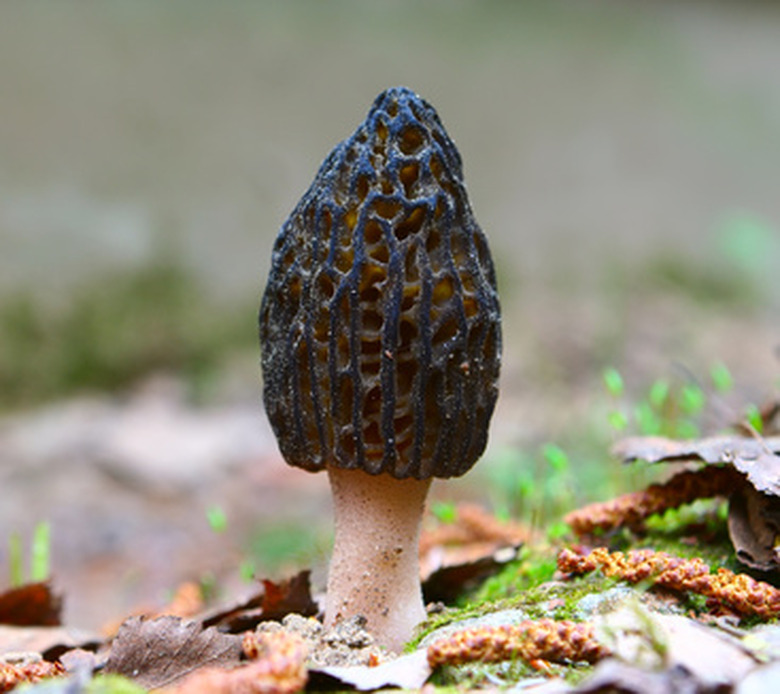How To Grow Mushrooms For Profit In Arkansas
Things Needed
- Mushroom
- Petri dish
- Agar mix
- Dishpan
- Ryegrass seed
- 3 aluminum cake pans
- Pressure cooker
- Oven bags
- Glass Mason jar with ring
- Disk-shaped filter
- Potting soil
- Sand
- Wood chips
- Rice hulls
- Soybean meal
- Peat moss
The state of Arkansas is roughly divided between the forested mountainous terrain of the Ozark and Ouachita mountains and the flatter delta region of the Mississippi river delta. The forestland of Arkansas makes an ideal environment for growing mushrooms. Commercial mushrooms that can be grown in Arkansas include shitake, oyster, truffles and morel. Although you can plant mushrooms to grow outdoors, growing mushrooms for profit means meeting a demand higher than casual outdoor production will provide. Instead, commercial growers will have to grow mushrooms indoors in a controlled environment to meet the demand of their buyers.
Step 1
Familiarize yourself with the life cycle of the mushrooms that you intend to grow as well as their growth requirements by studying plant pathology textbooks. The University of Arkansas maintains a plant pathology department and can recommend resources.
- The state of Arkansas is roughly divided between the forested mountainous terrain of the Ozark and Ouachita mountains and the flatter delta region of the Mississippi river delta.
- The University of Arkansas maintains a plant pathology department and can recommend resources.
Step 2
Collect mushroom spores by hanging a mushroom upside down over a Petri dish filled with prepared agar mix. Cover the dish and store between 55 and 80 degrees Fahrenheit for a few days.
Step 3
Place ryegrass seed in a dishpan and fill it with water until the ryegrass seed is completely covered. Soak for 24 hours. Drain and mix one part potting soil with five parts ryegrass seed. Place 2 cups of mix in a 1-quart Mason jar. Fit with filter disk and ring, and sterilize for one hour in a pressure cooker at 15 psi.
- Collect mushroom spores by hanging a mushroom upside down over a Petri dish filled with prepared agar mix.
Step 4
Remove from cooker, and add agar that has been infected with fungus to your jar. Replace the filter disk, and cover with foil to prevent drying. Shake the jar and store at 70 degrees in a dark place for four to six weeks.
Step 5
Make a substrate mix for growing your mushrooms by mixing two parts sand, three parts potting soil and five parts organic material. Your organic material should be made from eight parts hardwood chips, one part rice hulls, one-half part soybean meal and one-half part peat moss. You can also add powdered limestone to adjust the pH so that it is 7.1.
Step 6
Fill a cake pan with 2 inches of substrate. Saturate with water, and then completely drain. Fill a second cake pan with 2 inches of washed and drained ryegrass seed. Place the substrate pan on top of the ryegrass pan, and place both of them in an oven bag. Place the oven bag in a pressure cooker, and cook at 15 psi for an hour.
- Remove from cooker, and add agar that has been infected with fungus to your jar.
- Place the substrate pan on top of the ryegrass pan, and place both of them in an oven bag.
Step 7
Mix 1/2 cup of fungus from the jar with the substrate. Reclose the oven bag, and place the substrate in a dark place at around 70 degrees in a dark location with 100 percent humidity. After six weeks, there should be lumpy sclerotia "seeds" on top of the soil.
Step 8
Remove rye seed tray from bag, and store soil in a refrigerator with temperatures below 40 degrees for two weeks.
Step 9
Remove tray from refrigerator and discard bag. Saturate soil with sterile water for 12 hours. Allow soil to drain for 24 hours. Keep tray in 90 percent humidity with 12 hours of light daily. Mushrooms will germinate in seven days.
- Mix 1/2 cup of fungus from the jar with the substrate.
- Keep tray in 90 percent humidity with 12 hours of light daily.
Tip
Growing mushrooms in a tray is known as tray culture. Mushrooms such as shitake will also grow well if you inoculate logs with them and then leave the log in a protected, moist environment. This is known as log culture. An autoclave can be used in place of a pressure cooker. A pressure cooker will do quite well and is less expensive, but an autoclave may hold larger quantities of soil.
Warning
All equipment used to handle mushrooms and soil should be completely sterilized before it comes into contact with fungus. Unsterile equipment can contaminate your mushrooms, which may harm their growth.
